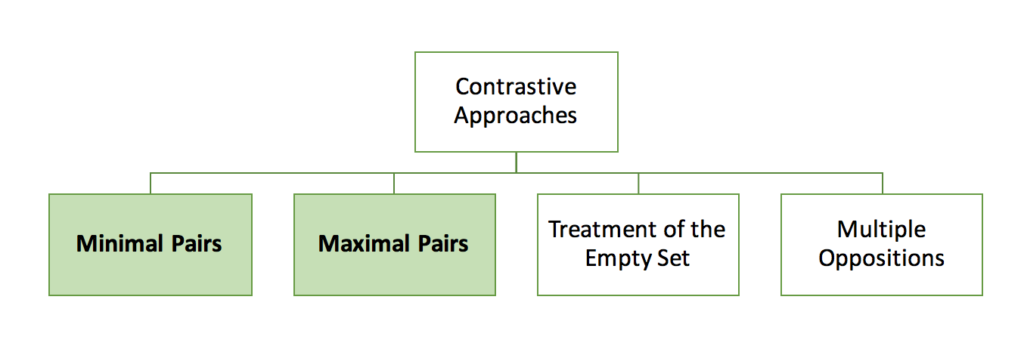Apart from the Cycles Approach and the Complexity Approach, the “Contrastive Approach” is another common way to treat children with phonological speech disorders. In this article, we explore both the so-called “Minimal Pairs Approach” and the “Maximal Pairs Approach”. Both are contrastive approaches and are used for phonological intervention.

Let’s dive into the nuts and bolts of these two approaches.
Who developed them?
The Minimal Pairs Approach was developed by Dr Frederick F. Weiner, whilst the Maximal Pairs Approach was developed by Professor Judith Gierut and her colleagues at Indiana University.
Who is it for?
- The Minimal Pairs Approach is suitable for children with mild or moderate speech sound disorders, with one or two phonological processes that are no longer age-appropriate. It can also be used with people who are looking to modify their accent.
- The Maximal Pairs Approach is geared towards children with at least six sounds missing from their speech sound inventories with normal oral and speech motor abilities.
What are they?
In essence, both approaches focus on contrasting differences between phonemes (i.e. speech sounds) in order to reorganise a child’s sound system.
Phonemes can differ by:
- Place – some sounds are made with the lips, tongue tip or the back of the tongue.
- Manner – some sounds uses a long continuous flow of air (e.g. /s/, /z/), some sounds are short and stop as soon as they begin (e.g. /t/, /p/), etc.
- Voicing – we switch our voices on to make some sounds (e.g. /b/, /g/), but turn our voices off for others (e.g. /p/, /k/).
In the case of a minimal pair, the two words differ by a single phoneme and by one or two features across place and manner of articulation and voicing.
For example, let’s look at the pair “cap” and “tap”. These two words are identical in terms of the vowel /ae/ and final consonant /p/. They only differ by the initial phoneme – /k/ and /t/ – and this involves a small difference in place of production (velar vs alveolar).
In comparison, a maximal pair includes two words that differ by a single phoneme across many featural dimensions of place, manner and voicing. An example would be the pair “be” and “see”, where the phonemes /b/ and /s/ differ across all three aspects of place (labial vs coronal), manner (stop vs fricative) and voicing (voiced vs voiceless).
In both approaches, the paired words would contain a sound a child is familiar with and a target (unfamiliar) sound.
What happens in the sessions?
For the Minimal Pairs Approach:
- Identify the target phonological process. For example, a 3-year-old boy, Ben, has voicing errors. He “turns off” his voice at the start of his words when he should be “turning it on” (e.g. he says “pig” instead of “big”). In this case, we want Ben to say /b/. We call this the “target”.
- Before the session, select 3-5 minimal pairs of words that contrast the paired phonemes. According to research, only three to five word pairs are needed to make permanent changes in a child’s phonological system (Elbert et al., 1991). In Ben’s case, we can choose pig/big, pay/bay, park/bark, peg/beg, pea/bee.
- Introduce the minimal pair words to the child by showing them pictures of the pairs and naming them aloud. We want to make sure Ben knows the vocabulary – this is sometimes tricky when contrasting sounds with few word options.
- Have the child point to the words you name. This gives us an idea whether the child can hear the difference between the two contrasting phonemes (e.g. /p/ vs /b/). This is sometimes called auditory discrimination.
- Now, reverse the roles and have the child name the words.
- When the child uses the “wrong sound” (e.g. pig) for the target (e.g. big), pick up the picture that the child named and not the one intended. For example, when Ben points to the picture card big but says, ‘pig’, pick up the picture of the pig.
- Give the child feedback to signal he/she has made a mistake. In Ben’s case, I might say, “Oh, do you mean pig or big? I’m not sure what you mean, tell me again.” This is the teaching moment, where Ben learns he needs to say the word differently for others to understand him.
- Work with the child till he/she gets it right about 60% of the time.
- Move onto the other paired words (one set at a time) at sentence level. You can use carrier phrases at this stage.
Here’s a demonstration (voice and hand talents Vivien Wong and Cherie Finocchiaro):

For the Maximal Pairs Approach:
- Identify the two target phonemes. For example, the sounds /m/ and /f/ are maximally opposed across by place, manner and voicing (with /m/ being a bilabial voiced nasal and /f/ being a labiodental voiceless fricative). Remember the pair should include a known versus an unknown phoneme.
- Create eight pairs of words containing the target phonemes. Where no true words are available, use nonsense words, which could be associated with different monster or fairy names. For example, Mip/Fip.
- Have the child imitate you and then say it on their own.
In both approaches, we also plan to add auditory bombardment and discrimination tasks.
How long does it take?
Like other approaches, the duration of therapy required is dependent on the child, the child’s phonological processes, the amount of treatment within sessions and home practice. The more repetitions we could fit into our sessions, the better.
As both approaches are suited for children with mild-to-moderate phonological impairments, with only a few age-inappropriate errors remaining, in theory at least, it should take less time than more intensive treatment approaches such as Cycles.
The idea is that, once a difference between phonemes is introduced, the gains are likely to “transfer” to untreated phonemes. (You can read more about this here.)
What does this mean?
If we think back to our earlier example with Ben, the phonemes /p/ and /b/ differ only by voicing (voiceless vs voiced). If Ben learns to “turn on” his voice in treatment of /p/ vs /b/ pairs, this same voicing contrast should be carried over to other voiceless-voiced pairs such as /t/-/d/ or /k/-/g/.
Does it work?
The Minimal Pairs Approach has been used for over twenty years, with a robust body of research supporting its clinical effectiveness (Barlow and Gierut, 2002). Tyler, Edwards and Saxman (1987) also found that this approach was best suited for children with only one or a select few phonological processes. Research comparing both the Minimal and Maximal Pairs Approach found that targeting a maximally opposed pair led to greater generalisation than a minimally opposed pair.
It is important to note that to date, most of the studies on contrast approaches are fairly small, without control groups. The current main body of available evidence is based primarily on non-randomised experimental and non-experimental studies (Baker & McLeod, 2004). More higher-quality research would help clinicians (and our clients).
Helpful Resources:
Head over to leading speech pathologist Caroline Bowen’s website, for her incredibly extensive library of useful information about both approaches, as well as her widely used resources for therapy.
Related articles:
- Lifting the lid on speech therapy: how we assess and treat children with unclear speech – and why
- Speech sound disorders
- How to treat speech sound problems 1: the Cycles Approach
- How to treat speech sound disorders 2: the Complexity Approach – more bang for your buck?
- 10 common speech error patterns seen in children of 3-5 years of age – and when you should be concerned
- In what order and by what age should my child have learned his/her speech sound consonants?
- How to use principles of motor learning to improve your speech
Principal sources:
- Baker, E., & McLeod, S. (2004). Evidence-based management of phonological impairment in children. Child Language Teaching and Therapy, 20(3), 261–285. Abstract available here.
- Barlow, J., & Gierut, J. (2002). Minimal Pair Approaches to Phonological Remediation. Seminars In Speech And Language, 23(1), 057–068. Abstract available here.
- Elbert, M., Powell, T., & Swartzlander, P. (1991). Toward a Technology of Generalization: How Many Exemplars Are Sufficient? Journal of Speech, Language, and Hearing Research, 34(1), 81–87.Abstract available here.
- Tyler, A.A., Edwards, M.L., & Saxman, J.H. (1987). Clinical application of two phonologically based treatment procedures. Journal of Speech and Hearing Disorders, 52m, 393-409.
Image: https://tinyurl.com/yck6xsfg

Hi there, I’m David Kinnane.
Principal Speech Pathologist, Banter Speech & Language
Our talented team of certified practising speech pathologists provide unhurried, personalised and evidence-based speech pathology care to children and adults in the Inner West of Sydney and beyond, both in our clinic and via telehealth.

